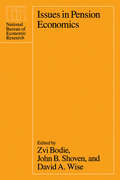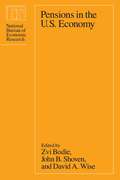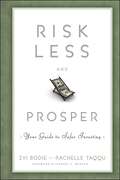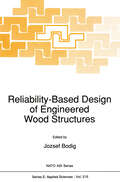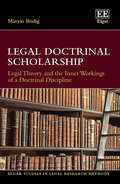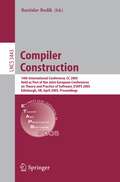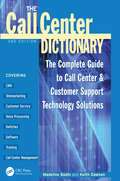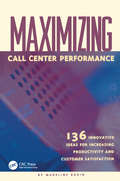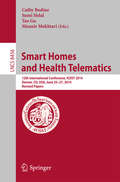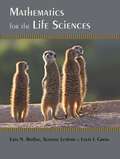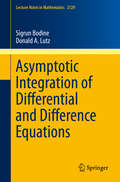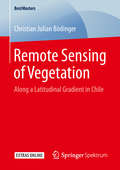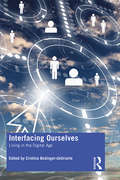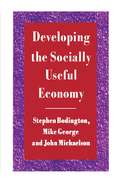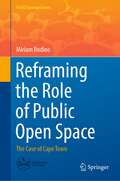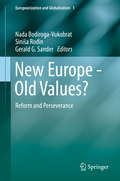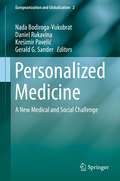- Table View
- List View
Issues in Pension Economics (National Bureau of Economic Research Project Report)
by Zvi Bodie John B. Shoven David A. WiseIn the past several decades, pension plans have become one of the most significant institutional influences on labor and financial markets in the U.S. In an effort to understand the economic effects of this growth, the National Bureau of Economic Research embarked on a major research project in 1980. Issues in Pension Economics, the third in a series of four projected volumes to result from thsi study, covers a broad range of pension issues and utilizes new and richer data sources than have been previously available. The papers in this volume cover such issues as the interaction of pension-funding decisions and corporate finances; the role of pensions in providing adequate and secure retirement income, including the integration of pension plans with social security and significant drops in the U.S. saving rate; and the incentive effects of pension plans on labor market behavior and the implications of plans on labor market behavior and the implications of plans for different demographic groups. Issues in Pension Economics offers important empirical studies and makes valuable theoretical contributions to current thinking in an area that will most likely continue to be a source of controversy and debate for some time to come. The volume should prove useful to academics and policymakers, as well as to members of the business and labor communities.
Issues in Pension Economics (National Bureau of Economic Research Project Report)
by Zvi Bodie John B. Shoven David A. WiseIn the past several decades, pension plans have become one of the most significant institutional influences on labor and financial markets in the U.S. In an effort to understand the economic effects of this growth, the National Bureau of Economic Research embarked on a major research project in 1980. Issues in Pension Economics, the third in a series of four projected volumes to result from thsi study, covers a broad range of pension issues and utilizes new and richer data sources than have been previously available. The papers in this volume cover such issues as the interaction of pension-funding decisions and corporate finances; the role of pensions in providing adequate and secure retirement income, including the integration of pension plans with social security and significant drops in the U.S. saving rate; and the incentive effects of pension plans on labor market behavior and the implications of plans on labor market behavior and the implications of plans for different demographic groups. Issues in Pension Economics offers important empirical studies and makes valuable theoretical contributions to current thinking in an area that will most likely continue to be a source of controversy and debate for some time to come. The volume should prove useful to academics and policymakers, as well as to members of the business and labor communities.
Pensions in the U.S. Economy (National Bureau of Economic Research Project Report)
by Zvi Bodie John B. Shoven David A. WisePensions in the U.S. Economy is the fourth in a series on pensions from the National Bureau of Economic Research. For both economists and policymakers, this volume makes a valuable contribution to current research on pensions and the economics of the elderly. The contributors report on retirement saving of individuals and the saving that results from corporate funding of pension plans, and they examine particular aspects of the plans themselves from the employee's point of view. Steven F. Venti and David A. Wise offer a careful analysis of who contributes to IRAs and why. Benjamin M. Friedman and Mark Warshawsky look at the reasons more retirement saving is not used to purchase annuities. Personal saving through pension contribution is discussed by B. Douglas Bernheim and John B. Shoven in the context of recent government and corporate pension funding changes. Michael J. Boskin and John B. Shoven analyze indicators of the economic well-being of the elderly, addressing the problem of why a large fraction of the elderly remain poor despite a general improvement in the economic status of the group as a whole. The relative merits of defined contribution versus defined benefit plans, with emphasis on the risk aspects of the two types of plans for the individual, are examined by Zvi Bodie, Alan J. Marcus, and Robert C. Merton. In the final paper, pension plans and worker turnover are the focus of the discussion by Edward P. Lazear and Robert L. Moore, who propose pension option value rather than the commonly used accrued pension wealth as a measure of pension value.
Pensions in the U.S. Economy (National Bureau of Economic Research Project Report)
by Zvi Bodie John B. Shoven David A. WisePensions in the U.S. Economy is the fourth in a series on pensions from the National Bureau of Economic Research. For both economists and policymakers, this volume makes a valuable contribution to current research on pensions and the economics of the elderly. The contributors report on retirement saving of individuals and the saving that results from corporate funding of pension plans, and they examine particular aspects of the plans themselves from the employee's point of view. Steven F. Venti and David A. Wise offer a careful analysis of who contributes to IRAs and why. Benjamin M. Friedman and Mark Warshawsky look at the reasons more retirement saving is not used to purchase annuities. Personal saving through pension contribution is discussed by B. Douglas Bernheim and John B. Shoven in the context of recent government and corporate pension funding changes. Michael J. Boskin and John B. Shoven analyze indicators of the economic well-being of the elderly, addressing the problem of why a large fraction of the elderly remain poor despite a general improvement in the economic status of the group as a whole. The relative merits of defined contribution versus defined benefit plans, with emphasis on the risk aspects of the two types of plans for the individual, are examined by Zvi Bodie, Alan J. Marcus, and Robert C. Merton. In the final paper, pension plans and worker turnover are the focus of the discussion by Edward P. Lazear and Robert L. Moore, who propose pension option value rather than the commonly used accrued pension wealth as a measure of pension value.
Risk Less and Prosper: Your Guide to Safer Investing
by Zvi Bodie Rachelle TaqquA practical guide to getting personal investing right Somewhere along the way, something has gone very wrong with the way individuals save and invest. Too often, households are drawn in by promotional suggestions masquerading as impartial investment advice. Consumers get saddled with more risk than they realize. Authors Zvi Bodie and Rachelle Taqqu understand the dilemma that today's investors face, and with Risk Less and Prosper they will help you find your financial footing. Written in an accessible style, this practical guide skillfully explains why personal investing is all about you—your goals, your values and your career path. It shows how to understand investment risk and choose the particular blend of risk and safety that is right for you. And it lays out several simple yet powerful ways for small investors to cast a reliable safety net to achieve their financial goals and truly prosper. Coauthors Bodie and Taqqu challenge the myth that all investments require risk, then highlight some important risks that families often disregard when deciding where to put their money. Later, they connect the dots between investment and investor, showing us all how to grasp our own investment risk profiles and how we may use these insights to make more fitting investment choices. Outlines a straightforward way to invest by aligning your investments with your goals and the risk levels you can bear Provides basic investment abc's for readers who are otherwise literate Lays out a simple, actionable plan for achieving your goals Explains the role of risk-free assets and investment insurance in assuring that you reach your most essential goals Contrary to popular belief, investing doesn't have to be complicated. You can build wealth without taking great risks. Risk Less and Prosper will show you how to make investment decisions that will make your financial life less stressful and more profitable.
Risk Less and Prosper: Your Guide to Safer Investing
by Zvi Bodie Rachelle TaqquA practical guide to getting personal investing right Somewhere along the way, something has gone very wrong with the way individuals save and invest. Too often, households are drawn in by promotional suggestions masquerading as impartial investment advice. Consumers get saddled with more risk than they realize. Authors Zvi Bodie and Rachelle Taqqu understand the dilemma that today's investors face, and with Risk Less and Prosper they will help you find your financial footing. Written in an accessible style, this practical guide skillfully explains why personal investing is all about you—your goals, your values and your career path. It shows how to understand investment risk and choose the particular blend of risk and safety that is right for you. And it lays out several simple yet powerful ways for small investors to cast a reliable safety net to achieve their financial goals and truly prosper. Coauthors Bodie and Taqqu challenge the myth that all investments require risk, then highlight some important risks that families often disregard when deciding where to put their money. Later, they connect the dots between investment and investor, showing us all how to grasp our own investment risk profiles and how we may use these insights to make more fitting investment choices. Outlines a straightforward way to invest by aligning your investments with your goals and the risk levels you can bear Provides basic investment abc's for readers who are otherwise literate Lays out a simple, actionable plan for achieving your goals Explains the role of risk-free assets and investment insurance in assuring that you reach your most essential goals Contrary to popular belief, investing doesn't have to be complicated. You can build wealth without taking great risks. Risk Less and Prosper will show you how to make investment decisions that will make your financial life less stressful and more profitable.
Reliability-Based Design of Engineered Wood Structures (NATO Science Series E: #215)
by J. BodigReliability-based design (RBD) procedures for engineered structures are being developed and quickly gaining acceptance by cade agencies throughout the world. Numerous organizations are involved in the development of national or regional cades without the benefit of interchange of ideas and methodologies. Harmonization and coordination of these activities is absolutely essential if the ever-increasing international commerce is to flourish. This NATO Advanced Research Workshop (ARW) was organized to bring together, for the first time, experts on RBD and related subjects from various countries to assess the current knowledge and recommend new developments. Further, due to their unique nature and great economic significance in most parts of the world, special emphasis was placed on engineered wood structures. For example, in North America more wood products are used in construction than ali other materials (steel, concrete, brick, etc.) combined. However, the wood industry segment, historically, receives less attention and smaller financial support for new developments than other construction materials. RBD developments are being conducted in Similar, but largely independent, Europe, North America, New Zealand and Australia. Experts from these regions were brought together to exchange information on current work, propose new developments and to provide means of international coordination. Thus, this ARW provided an opportunity to advance the cause of RBD of engineered wood structures.
Legal Doctrinal Scholarship: Legal Theory and the Inner Workings of a Doctrinal Discipline (Elgar Studies in Legal Research Methods)
by Mátyás BódigProviding a comprehensive account of the often-misunderstood area of legal doctrinal scholarship, this incisive book offers a novel framing for conceptual legal theory and the functions of conceptual theorising in legal studies. It explores the ways in which a doctrinally-oriented legal theory may provide methodological support to legal scholars, arguing that making adequate sense of the rational reconstruction of law is pivotal in delivering such active support.The epistemological key to the central themes of the book is the idea that doctrinal disciplines are anchored in the concept of 'doctrinal knowledge', the practice-specific normative knowledge used to navigate institutionalised social practices. The distinctive epistemological and political philosophical grounding for legal doctrinal scholarship demonstrated in this book facilitates a rich analysis of the three core models of interdisciplinary engagement characteristic of legal scholarship.Considering how legal doctrinal scholarship cultivates doctrinal knowledge by way of hermeneutic engagement with positive law, this thought-provoking book will be a key resource for students and scholars of constitutional law, criminal law, private law and international law. It will also be of benefit to legal theorists, philosophers and practitioners.
Compiler Construction: 14th International Conference, CC 2005, Held as Part of the Joint European Conferences on Theory and Practice of Software, ETAPS 2005, Edinburgh, UK, April 4-8, 2005. Proceedings (Lecture Notes in Computer Science #3443)
by Rastislav BodikETAPS 2005 was the eighth instance of the European Joint Conferences on Theory and Practice of Software. ETAPS is an annual federated conference that was established in 1998 by combining a number of existing and new conf- ences. This year it comprised ?ve conferences (CC, ESOP, FASE, FOSSACS, TACAS), 17 satellite workshops (AVIS, BYTECODE, CEES, CLASE, CMSB, COCV, FAC, FESCA, FINCO, GCW-DSE, GLPL, LDTA, QAPL, SC, SLAP, TGC, UITP), seven invited lectures (not including those that were speci?c to the satellite events), and several tutorials. We received over 550 submissions to the ?ve conferences this year, giving acceptance rates below 30% for each one. Congratulations to all the authors who made it to the ?nal program! I hope that most of the other authors still found a way of participating in this exciting event and I hope you will continue submitting. The events that comprise ETAPS address various aspects of the system - velopment process, including speci?cation, design, implementation, analysis and improvement. The languages, methodologies and tools which support these - tivities are all well within its scope. Di?erent blends of theory and practice are represented, with an inclination towards theory with a practical motivation on the one hand and soundly based practice on the other. Many of the issues involved in software design apply to systems in general, including hardware s- tems,andtheemphasisonsoftwareisnotintendedtobeexclusive.
The Call Center Dictionary: The Complete Guide to Call Center and Customer Support Technology Solutions
by Madeline BodinYour company needs a call center to be competitive in the 21st century. This book is your guide to the technology, techniques, and trends in today's call centers. The Call Center Dictionary contains all the information you need to: Understand: Your boss,
Maximizing Call Center Performance: 136 Innovative Ideas for Increasing Productivity and Customer Satisfaction
by Madeline BodinEver wish you could find out how North America's biggest and most advanced call centers are really using call center technology? Want to know how successful call centers have solved the problems behind basic call center functions such as order handling, h
Smart Homes and Health Telematics: 12th International Conference, ICOST 2014, Denver, CO, USA, June 25-27, 2014, Revised Papers (Lecture Notes in Computer Science #8456)
by Cathy Bodine Sumi Helal Tao Gu Mounir MokhtariThis book constitutes the thoroughly refereed post-conference proceedings of the 12th International Conference on Smart Homes and Health Telematics, ICOST 2014, held in Denver, CO, USA in June 2014.The 21 revised full papers presented together with three keynote papers and 9 short papers were carefully reviewed and selected from numerous submissions. The papers are organized in topical sections on Design and Usability, assistive and sentient environments, cognitive technology, activity recognition, context and situation awareness, Health IT and short contributions.
Mathematics for the Life Sciences
by Erin N. Bodine Suzanne Lenhart Louis J. GrossThe life sciences deal with a vast array of problems at different spatial, temporal, and organizational scales. The mathematics necessary to describe, model, and analyze these problems is similarly diverse, incorporating quantitative techniques that are rarely taught in standard undergraduate courses. This textbook provides an accessible introduction to these critical mathematical concepts, linking them to biological observation and theory while also presenting the computational tools needed to address problems not readily investigated using mathematics alone.Proven in the classroom and requiring only a background in high school math, Mathematics for the Life Sciences doesn't just focus on calculus as do most other textbooks on the subject. It covers deterministic methods and those that incorporate uncertainty, problems in discrete and continuous time, probability, graphing and data analysis, matrix modeling, difference equations, differential equations, and much more. The book uses MATLAB throughout, explaining how to use it, write code, and connect models to data in examples chosen from across the life sciences.Provides undergraduate life science students with a succinct overview of major mathematical concepts that are essential for modern biologyCovers all the major quantitative concepts that national reports have identified as the ideal components of an entry-level course for life science studentsProvides good background for the MCAT, which now includes data-based and statistical reasoningExplicitly links data and math modelingIncludes end-of-chapter homework problems, end-of-unit student projects, and select answers to homework problemsUses MATLAB throughout, and MATLAB m-files with an R supplement are available onlinePrepares students to read with comprehension the growing quantitative literature across the life sciencesA solutions manual for professors and an illustration package is available
Mathematics for the Life Sciences
by Erin N. Bodine Suzanne Lenhart Louis J. GrossThe life sciences deal with a vast array of problems at different spatial, temporal, and organizational scales. The mathematics necessary to describe, model, and analyze these problems is similarly diverse, incorporating quantitative techniques that are rarely taught in standard undergraduate courses. This textbook provides an accessible introduction to these critical mathematical concepts, linking them to biological observation and theory while also presenting the computational tools needed to address problems not readily investigated using mathematics alone.Proven in the classroom and requiring only a background in high school math, Mathematics for the Life Sciences doesn't just focus on calculus as do most other textbooks on the subject. It covers deterministic methods and those that incorporate uncertainty, problems in discrete and continuous time, probability, graphing and data analysis, matrix modeling, difference equations, differential equations, and much more. The book uses MATLAB throughout, explaining how to use it, write code, and connect models to data in examples chosen from across the life sciences.Provides undergraduate life science students with a succinct overview of major mathematical concepts that are essential for modern biologyCovers all the major quantitative concepts that national reports have identified as the ideal components of an entry-level course for life science studentsProvides good background for the MCAT, which now includes data-based and statistical reasoningExplicitly links data and math modelingIncludes end-of-chapter homework problems, end-of-unit student projects, and select answers to homework problemsUses MATLAB throughout, and MATLAB m-files with an R supplement are available onlinePrepares students to read with comprehension the growing quantitative literature across the life sciencesA solutions manual for professors and an illustration package is available
All I Want Is You
by Sherrill BodineFans of New York Times bestselling authors Carly Phillips, Jennifer Probst and Julie James will fall in love with Sherrill Bodine! SHE'S STEALING HIS HEART . . . Vintage boutique owner Venus Smith is stunned to realize her newest acquisition comes with a larcenous legend. Stolen years ago, the antique mermaid brooch belongs to the Clayworth family. The right thing to do would be to return it, but that means facing Connor Clayworth O'Flynn, the sexy department store heir Venus has had an unrequited crush on since childhood-and the man who helped ruin her father. ONE KISS AT A TIME Connor knows that Venus has never forgiven him for what happened between their families. But business isn't personal, even though Venus's father's betrayal still cuts him like a knife. So when Venus proposes a deal-she'll return his family's brooch if he helps clear her father's name-he reluctantly agrees. As action-packed days turn into flirtatious fall nights, it isn't long before old memories resurface . . . and new desires ignite. Can two young lovers leave the past behind? Or must they first admit that all they've ever really wanted . . . is each other?
A Black Tie Affair
by Sherrill BodineFans of New York Times bestselling authors Carly Phillips, Jennifer Probst and Julie James will fall in love with Sherrill Bodine! Suited for Seduction Fashion curator Athena Smith will do anything to get her perfectly manicured hands on the Clayworth family's celebrated couture collection for her exhibit. So when she's called in to make sure the gowns are the real deal, she's ecstatic...until a dress she's examining turns out to be loaded with toxins (talk about killer threads!) and Athena faints, only to wake up face-to-face with the One That Got Away, notorious Chicago bachelor Drew Clayworth. Drew still believes Athena betrayed him all those years ago, and he's sure he can't trust her. But when the priceless gowns go missing, she offers to help track them down. Reluctantly allied in the quest, Drew and Athena are soon stunned by the barely restrained passion still sizzling between them...and memories both bitter and sweet. Is their new partnership just a business arrangement? Or is this something more than... A Black Tie Affair
Talk of the Town
by Sherrill BodineFans of New York Times bestselling authors Carly Phillips, Jennifer Probst and Julie James will fall in love with Sherrill Bodine! GOSSIP QUEEN DETHRONED! Darlings, what a to-do at the Daily Mail today! After fifteen years as Chicago's gossip guru, Rebecca Covington has been demoted from divulger of secrets for the city's elite to headlining recipes in the Home and Food section. Apparently, a touchy senator is threatening legal action for Rebecca's latest extramarital scoop. But Windy City rumor has it that new CEO and dreamy Pierce Brosnan look-alike David Sumner downgraded Rebecca in favor of fresher, younger blood on the social beat. Industry insiders expect Rebecca to fight her denouement, and inquiring minds have already seen the feisty maven trading quips and searing glances wtih her arresting new boss. Rebecca swears she'll reclaim her shining star status, but can the dishy diva even cook? And how can she ignore David's arousing effect on her sensibilities? Don't miss a trick, darlings. Sparks are going to fly.
Asymptotic Integration of Differential and Difference Equations (Lecture Notes in Mathematics #2129)
by Sigrun Bodine Donald A. LutzThis book presents the theory of asymptotic integration for both linear differential and difference equations. This type of asymptotic analysis is based on some fundamental principles by Norman Levinson. While he applied them to a special class of differential equations, subsequent work has shown that the same principles lead to asymptotic results for much wider classes of differential and also difference equations.After discussing asymptotic integration in a unified approach, this book studies how the application of these methods provides several new insights and frequent improvements to results found in earlier literature. It then continues with a brief introduction to the relatively new field of asymptotic integration for dynamic equations on time scales.Asymptotic Integration of Differential and Difference Equations is a self-contained and clearly structured presentation of some of the most important results in asymptotic integration and the techniques used in this field. It will appeal to researchers in asymptotic integration as well to non-experts who are interested in the asymptotic analysis of linear differential and difference equations. It will additionally be of interest to students in mathematics, applied sciences, and engineering. Linear algebra and some basic concepts from advanced calculus are prerequisites.
Remote Sensing of Vegetation: Along a Latitudinal Gradient in Chile (BestMasters)
by Christian Julian BödingerHow is the vegetation distribution influencing the erosion and surface formation in the different eco zones of Chile? To answer this question, it is mandatory to possess fundamental knowledge about plant species habitats, occurrence and their dynamics. In his study Christian Bödinger utilizes satellite imagery in combination with machine learning to derive maps of land use and land cover (LULC) in four study sites along a climatic gradient and to monitor vegetation using monthly Normalized Difference Vegetation Index (NDVI) time series. The findings contribute to a better understanding of climate impacts on Chilean vegetation and serve as a basis of landscape evolution models. About the Author: Christian Bödinger holds a M.Sc. in Physical Geography from the University of Tübingen, Germany. His focus in research lies on remote sensing and image analysis for environmental applications. He is currently working for a company focusing on aquatic remote sensing.
Interfacing Ourselves: Living in the Digital Age
by Cristina Bodinger-DeUriarteInterfacing Ourselves consists of new work that examines digital life on three levels: individuals and digital identity; relationships routinely intertwining digital and physical connections; and broader institutional and societal realities that define the context of living in the digital age. A key focus is what it means in varied social arenas when most individuals live as co-present or multi-present—simultaneously engaged in digital and physical space—alone and with others. Topics include how: digital life contributes to well-being; individuals experience digital dependency; a smartphone is more than a smartphone; netiquette reveals social change; some online communities become prosocial salient havens while others reinforce social inequality; Millennials build intimacy; Latinx do familismo; and digital surveillance and big data redefine consumerism, advocacy, and civic engagement. Six chapters incorporate insights from hourly journals of Millennials undergoing a period of digital abstinence. Other chapters draw from surveys, digital auto-ethnography, content analysis, and other methods to explore digital life at the level of individual and interactive experience, and at a broader institutional and societal level. Ultimately, the book presents the need for living a mindful digital life by developing greater awareness as an individual, a social being, and a netizen and citizen.
Interfacing Ourselves: Living in the Digital Age
by Cristina Bodinger-DeUriarteInterfacing Ourselves consists of new work that examines digital life on three levels: individuals and digital identity; relationships routinely intertwining digital and physical connections; and broader institutional and societal realities that define the context of living in the digital age. A key focus is what it means in varied social arenas when most individuals live as co-present or multi-present—simultaneously engaged in digital and physical space—alone and with others. Topics include how: digital life contributes to well-being; individuals experience digital dependency; a smartphone is more than a smartphone; netiquette reveals social change; some online communities become prosocial salient havens while others reinforce social inequality; Millennials build intimacy; Latinx do familismo; and digital surveillance and big data redefine consumerism, advocacy, and civic engagement. Six chapters incorporate insights from hourly journals of Millennials undergoing a period of digital abstinence. Other chapters draw from surveys, digital auto-ethnography, content analysis, and other methods to explore digital life at the level of individual and interactive experience, and at a broader institutional and societal level. Ultimately, the book presents the need for living a mindful digital life by developing greater awareness as an individual, a social being, and a netizen and citizen.
Developing the Socially Useful Economy
by Stephen Bodington Mike George John Michaelson"[Based on a series of] seminars ... organised by CAITS (Centre for Alternative Industrial and Technological Systems) and Middlesex Polytechnic staff [in 1984]"--P. ix.
Reframing the Role of Public Open Space: The Case of Cape Town (PoliTO Springer Series)
by Miriam BodinoThis book explores the growing spatial inequality in contemporary cities, and the opportunity of reframing the role of public open space as a tool of inclusion in a context of an increasing economic gap between the urban poor and rich. The first part outlines the geographical and theoretical frames of reference, which are then tested in the analysis of a case study: Cape Town. This city in South Africa was selected since its spatial aspects of separation are particularly evident due to the legacy of both apartheid and modernism. The examination of the policies of the City of Cape Town confirms the rising attention to public space since the 1990s. This slow progress of desegregation is tested through a critical study of one of the most disadvantaged areas of the city, Khayelitsha. The book explores the relevance and impact of an urban-design project, and reframes the role of public open space not only as a tool for restructuring the apartheid city, but also for reinterpreting other fragmented contemporary cities.
New Europe - Old Values?: Reform and Perseverance (Europeanization and Globalization #1)
by Nada Bodiroga-Vukobrat Siniša Rodin Gerald SanderThis book explores the reactions to Europeanization and globalization in times of economic distress, including the transformation of European values in national legal cultures. The authors explore how European values, tradition and new legal challenges interconnect and dictate the paths of transition between old and new Europe. The first chapter starts with a question: can Roman Legal Tradition play a role of identity factor towards a New Europe? Can it be considered as a general value identifying new Europe, built on a minimum core of principles – persona, dominum, obligation, contract and inheritance – composing the whole European private law tradition? Subsequent chapters attempt to provide possible responses to the question: what is Europe today? The answers diverge, depending on the research area. The inherent dichotomy of human rights protection in Europe and the concept of ‘one law, one court’ are investigated in the second chapter, whereas the third chapter focuses on asylum and the interrelation and interdependence of the Court of Justice of the EU and the European Court of Human Rights. The next three chapters concentrate on matters of equal treatment and non-discrimination. The first contribution in this part reflects on the crisis and methodological and conceptual issues faced by modern anti-discrimination law. It is followed by a specific analysis of the empowerment of women or gender-balancing in company boards. The third contribution reveals the impact of the Croatian anti-discrimination law on private law relations. The next chapter deals with the issue of social rights in Croatia and the method of their regulation in the context of the new European values. The immense challenges posed by the market integration imperative and democratic transition have brought about different reactions in the national legal systems and legal cultures of both old and new Member States. As such, Europe has effectively been reunited, but what about the convergence of national legal cultures? This is the focal point of the remaining chapters, which focus on various issues, from internal market, competition law, consumer welfare, liberalization of network industries to the EU capital market. The magnitude of EU activity in these areas offers conclusive evidence that old and new paradigms are evolving and shaping the future of the EU.
Personalized Medicine: A New Medical and Social Challenge (Europeanization and Globalization #2)
by Nada Bodiroga-Vukobrat Daniel Rukavina Krešimir Pavelić Gerald G. SanderThis book offers comprehensive coverage of the various aspects of personalized medicine as an original approach to classifying, understanding, treating and preventing disease based on individual biological differences. In the introductory section, it defines personalized medicine as a way toward new medical practices and addresses the question: What can personalized medicine offer citizens, medical professionals, reimbursement bodies and stakeholders? Subsequent chapters discuss the technological aspects of personalized medicine: data collection, comprehensive integration and handling of data, together with key enabling factors in developing the requisite technological support for personalized medicine. Lastly, the book explores the main issues shaping the implementation and development of personalized medicine – education, stakeholder participation, infrastructure, a new approach to the classification of disease and medical tests, regulatory frameworks, and new reimbursement models – together with ethical, legal and social issues. Ultimately, the book calls for interdisciplinarity and a radical change in the way we approach the health and wellbeing of individuals. Target groups are medical doctors and researchers in the field of biomedicine, as well as experts from the social sciences dealing with legal, economic and social aspects of health system issues in general. Though the book will primarily benefit these groups of professional experts, its content will also appeal to a far wider readership, as it deals with a paradigm shift in one of society’s main pillars – the health system.
